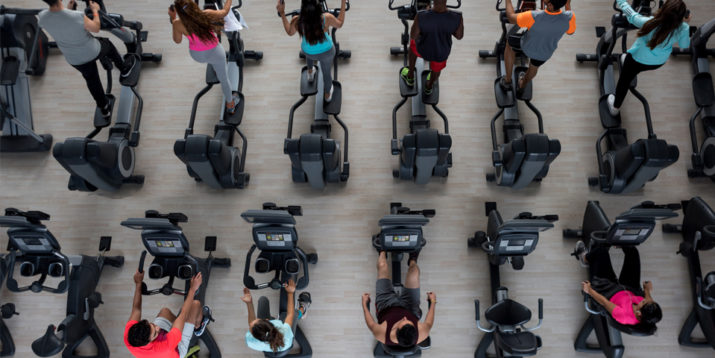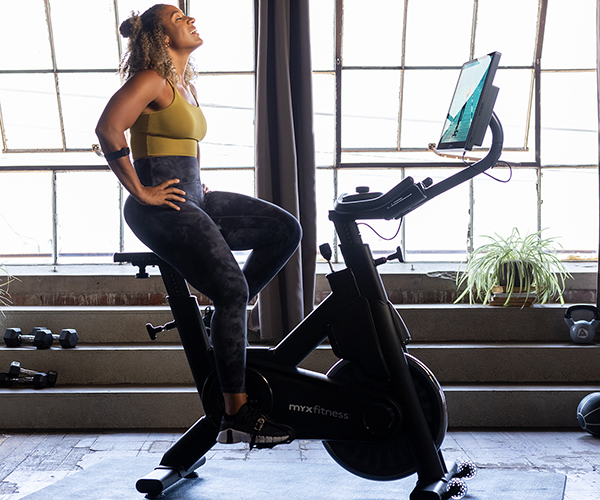What Counts as Cardio — and How Often Should You Do It?

You know you should do it. You know it can be a boon to health. You know it involves sweating. But beyond that, what is cardio exercise exactly? How does it affect the body differently from other forms of exercise? What counts as cardio and what doesn’t? How often should you do it, and how should you do it?
What Is Cardio Exercise?
“Cardio is anything that A) Raises your heart and breathing rates, and B) Improves the function of your heart, lungs, and circulatory system,” says Trevor Thieme, C.S.C.S.
That typically requires more intensity than most folks realize.
“People tend to think of cardio in terms of steady-state exercise, like jogging. But the definition is simultaneously simpler and more complex.” To bring more clarity to this type of exercise, let’s tackle a few common cardio misconceptions, one at a time:
So, cardio is any exercise that increases your heart rate?

Not quite. Just about any physical activity you do can increase your heart rate, from lifting weights at the gym to strolling between your desk and the bathroom to rolling out of bed in the morning. For an activity to qualify as a cardio workout, it has to meet both criteria mentioned above.
In short, it has to raise your heart and breathing rates and challenge your cardiovascular system, just like a biceps exercise has to challenge your biceps and an abdominal exercise has to challenge your abs.
While leisurely activities like walking and easy bike riding have benefits of their own and are cardiovascular in nature, they aren’t cardio exercises (unless you are very deconditioned). That’s because they don’t challenge your heart and lungs enough to improve their function.
Is cardio the same thing as “aerobic exercise?”

Not exactly. Aerobic exercise is a form of cardio — but it’s not the only one. Think of your body as a hybrid vehicle with two engines: one is aerobic, meaning it requires oxygen to run, while the other is anaerobic, meaning it doesn’t need oxygen. Both engines are always active, but depending on the duration and intensity of your workout, one will be used more than the other.
The aerobic system is best for long and relatively easy activities — the stuff you spend most of your day doing: working at a desk, eating, walking — and for lower-intensity forms of exercise, like jogging. You can emphasize the aerobic system with continuous low-intensity activity lasting 20 minutes or more.
The anaerobic engine is for fast and intense activities, like squatting a barbell or sprinting all-out for 30 seconds. It’s also emphasized during repeated bursts of intense activity, such as cardio workouts involving high-intensity interval training (HIIT).
Mountains of research in the last two decades (including this study) show that both aerobic and anaerobic workouts can improve cardiovascular functioning — and so both approaches qualify as “cardio” exercise.
Do you have to run, bike, or swim for it to qualify as cardio?

Not necessarily. When it comes to cardio, it’s not what you do — it’s how you do it.
“The umbrella of cardio encompasses much more than a long run,” Thieme says. “It also includes HIIT workouts, dancing, and some types of strength training (like circuit training). Even vigorous household activities count (like raking leaves, moving furniture, or carrying groceries upstairs) if you do them with enough commitment and intensity.”
To see if an activity counts, use the talk test: If you find it difficult to speak, even in short sentences, then that likely means you’re in the right range for the activity to qualify as cardio exercise.
If you’re tracking your performance with a heart rate monitor, you can determine the intensity of an activity using heart rate zones:
Zone 1 = 50%-60% of your max heart rate (very light effort)
Zone 2 = 60%-70% of MHR (light effort)
Zone 3 = 70%-80% of MHR (moderate effort)
Zone 4 = 80%-90% of MHR (hard effort)
Zone 5 = 90%-100% of MHR (maximum effort)
To learn how to calculate your maximum heart rate, click here.
Examples of Cardio Exercises
Cardio exercises come in many different forms:
- Running
- Walking
- Cycling
- Swimming
- Stair climbing
- Kickboxing
- Sports
- Dancing
- Jumping rope
- HIIT
Your cardio options are almost limitless. You just need to keep the intensity high enough to challenge your heart and lungs.
Cardio can be a steady-state exercise that’s done at low to moderate intensity, like jogging on a treadmill or an easy bike ride.
Cardio can also be intervals of high-intensity exercise, like HIIT, where you go all out for 20- to 120-second bursts, and then rest just long enough to allow you to perform the next round with equal intensity. Examples include Tabata and Shaun T’s program, Transform :20.
Just keep in mind that whatever cardio activity you choose should involve large muscle groups in the legs and trunk, since smaller muscle groups like the biceps and calves don’t create an oxygen demand large enough to tax the cardiovascular system on their own.
How Often Do You Need to Do Cardio?
The amount of cardiovascular exercise you should get may differ from that of others, depending on variables that include age, specific goals, and level of fitness. However, the U.S. Department of Health and Human Services’ Physical Activity Guidelines broadly recommend adults get either:
• At least 150 to 300 minutes (2½ to 5 hours) a week of moderate-intensity aerobic activity, or
• 75 to 150 minutes (one hour, 15 minutes to 2“½ hours) a week of high-intensity aerobic activity, or
• An equivalent combination of moderate- and vigorous-intensity aerobic activity
7 Benefits of Cardio

What is cardio good for, and why should you bother doing it? Like brushing your teeth and sleeping for seven to eight hours a night, it’s one of the most indisputably healthy activities you can do.
1. Heart strength
The word “cardio” is derived from the Greek kardia, meaning “heart,” which is the body’s primary beneficiary of cardiovascular activity. Regular exercise forces the heart to work, increasing its size and strength, improving blood flow to muscles and vital organs over time.
2. Lung capacity
The oxygen you draw with each breath is transferred via your lungs to your blood vessels for use in a host of metabolic processes. The more cardiovascular exercise you get, the greater your lungs’ capacity for oxygen and the more efficiently they can distribute it throughout the body.
This is what is meant by the term “cardiorespiratory,” which refers to the relationship between the heart and lungs. “Cardiovascular,” alternatively, refers to the relationship between the heart and blood vessels.
3. Joint health
You’ve gotta move your body to rev up your heart rate. That movement requires taking your joints through ranges of motion that help keep them mobile and vital.
4. Weight loss and maintenance
Losing weight requires expending more calories than you consume; maintaining weight entails striking a balance between calories in and calories out. Either way, cardiovascular exercise helps protect against the third caloric alternative: burning less than you ingest, which results in weight gain.
5. Mental health
Cardiovascular exercise stimulates the production of dopamine and serotonin, chemical messengers that help regulate feelings of happiness and motivation. The greater the levels of these neurotransmitters, the greater their mood-boosting potential.
A meta-analysis of two million person-years found an 18 percent lower risk of depression among participants who regularly engaged in light to moderate cardio.
6. Immune function
While the reasons aren’t fully understood, regular, moderate-intensity exercise has been found to benefit immune health. Possible explanations may include positive effects on inflammation, white blood cell production, and the relief of psychological stress.
7. Healthy blood pressure
Physically active people are likelier to enjoy blood pressure that falls within normal ranges. This may be attributable to a number of factors, including the effect of exercise on heart strength, epithelial tissue (blood vessels), and/or insulin sensitivity.
How to Pick the Best Cardio Workout For You
A study in the Journal of Physiology found that four to five cardio workouts a week is optimal for cardiovascular health and longevity. Over a lifetime, that’s a lot of time in the cardio saddle. So how should you spend it?
Since cardio exercise can encompass a vast range of activities — from stationary cycling to dancing to vacuuming — you have many options from which to choose, and you should choose several for your routine. After all, you don’t have to confine cardio to workouts — you can weave it into your everyday life as well.
Use these four factors to help you choose which type of cardio is best for you:
- Convenience. Whatever type of cardio you choose to do regularly, make it something that’s convenient. In other words, don’t commit to swimming workouts if you don’t have easy access to a pool or cycling workouts if you don’t have easy access to clear roads or a bike path (or a spin bike). Ideally, you should choose something that involves minimal preparation and equipment, like home workouts.
- Preference. The Internet is overflowing with advice on what the best type of cardio is, but ultimately, the best cardio workout is the one you’ll do consistently. Pick something you’ll be excited to do. If you’re interested in variety, check out Morning Meltdown 100. Short on time? Try Transform :20. Since cardio encompasses so many activities, don’t limit yourself to something you have to force yourself to do.
- Physical limitations. If you have a history of joint injuries, particularly to your knees, ankles, and lower back, you should avoid high-impact workouts. Stick to low-impact cardio activities like PiYo — this Pilates-yoga hybrid workout will boost your heart rate and get you sweating without any jumping or pounding on your joints.
- Time. Some people live for a 4-hour weekend bike ride. Others would rather get it done fast and get out. Luckily, cardio can be done in less than 30 minutes. Try the sweat-inducing cardio workouts from 22 Minute Hard Corps. If you’re pressed for time, HIIT cardio workouts are a great, time-saving option. Here are some of our favorite workouts under 30 minutes. Whatever you choose, just be sure that it fits your schedule.
BODi Cardio Workouts You Can Do at Home
If you’re ready to turn all of your newly acquired cardio training knowledge into cardio training experience, choose from the dozens of workouts on BODi.
Tough Mudder T-MINUS 30
 Four-time Tough Mudder X champion Hunter McIntyre helps you get into crazy shape in just 30 days of hard-charging, heart-challenging workouts that focus on building total-body strength, cardio endurance, and functional mobility. Whether you’re trying to conquer a Tough Mudder or just quantum-leap your fitness, T-MINUS 30 can help you get into the best shape of your life.
Four-time Tough Mudder X champion Hunter McIntyre helps you get into crazy shape in just 30 days of hard-charging, heart-challenging workouts that focus on building total-body strength, cardio endurance, and functional mobility. Whether you’re trying to conquer a Tough Mudder or just quantum-leap your fitness, T-MINUS 30 can help you get into the best shape of your life.
600 Secs
 If you have 10 minutes, you have enough time to get an effective cardio workout. Trainer Devin Wiggins wrings out every last one of those 600 seconds with high-intensity workouts that maximize your fat burning and muscle building potential. Two or more workouts can also be stacked to create a longer, even more effective training session.
If you have 10 minutes, you have enough time to get an effective cardio workout. Trainer Devin Wiggins wrings out every last one of those 600 seconds with high-intensity workouts that maximize your fat burning and muscle building potential. Two or more workouts can also be stacked to create a longer, even more effective training session.
Xtend Barre
 These 30-minute versions of Andrea Rogers‘ signature studio class combine Pilates, ballet fundamentals, and high-energy cardio to help burn fat and sculpt a more muscular physique. Xtend Barre incorporates the isometric exercises of traditional barre workouts with dynamic, full range-of-motion movements that keep it fun, fresh, and challenging.
These 30-minute versions of Andrea Rogers‘ signature studio class combine Pilates, ballet fundamentals, and high-energy cardio to help burn fat and sculpt a more muscular physique. Xtend Barre incorporates the isometric exercises of traditional barre workouts with dynamic, full range-of-motion movements that keep it fun, fresh, and challenging.
Rough Around the Edges
 This intense, results-driven training program is led by a team of professional stuntwomen, who teach you the actual moves they do to get ready for their roles. The result is a series of challenging, unconventional workouts — like Dance Fight MMA, Action Star Cardio, Booty Building Boxing, and Firecracker Weighted Core — designed to burn fat and build strength.
This intense, results-driven training program is led by a team of professional stuntwomen, who teach you the actual moves they do to get ready for their roles. The result is a series of challenging, unconventional workouts — like Dance Fight MMA, Action Star Cardio, Booty Building Boxing, and Firecracker Weighted Core — designed to burn fat and build strength.
